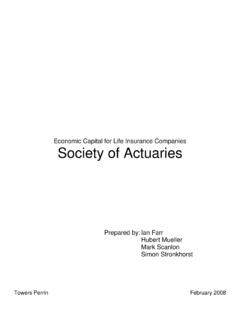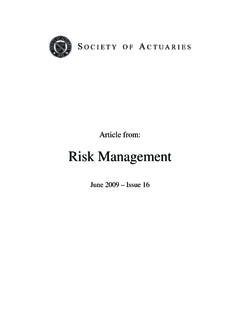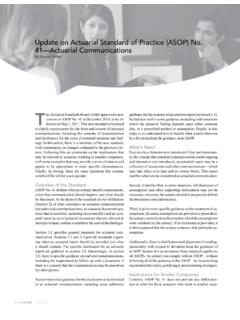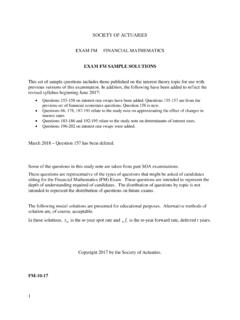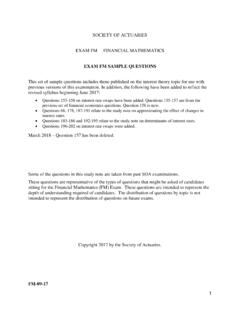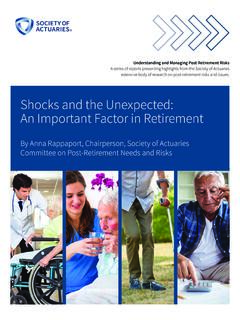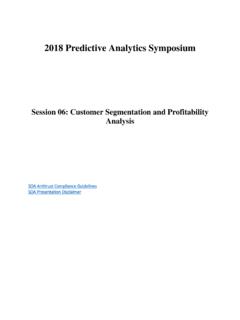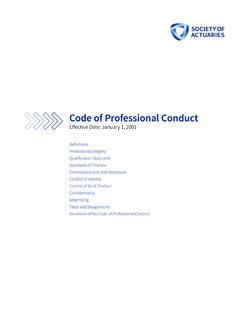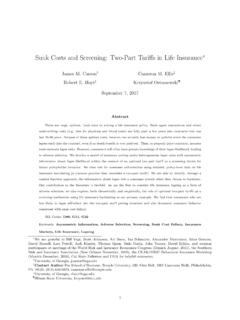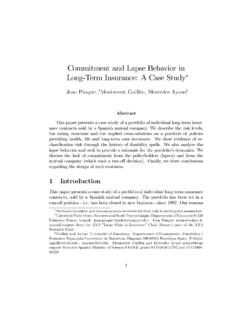Transcription of Predictive Modeling for Life Insurers - Member | SOA
1 Predictive Modeling for life Insurers Application of Predictive Modeling Techniques in Measuring Policyholder behavior in Variable Annuity Contracts April 30, 2010 Guillaume Briere-Giroux, FSA, MAAA, CFA Jean-Felix Huet, FSA Robert Spaul, FIA Andy Staudt, FCAS, MAAA David Weinsier, FSA, MAAA Predictive Modeling for life Insurers 2010 Towers Watson ABSTRACT Since the end of 2003, variable annuity (VA) assets have exceeded $1 trillion (source: Towers Watson VALUE Survey). The appeal of this product to the market can be attributed to the combination of a direct investment in the equity markets with the guarantees commonly offered with these products (GMDB, GMIB, GMAB and GMWB)1.
2 Policyholder behavior is a primary profit and risk driver for VA business, and accurate Modeling of this assumption is therefore critical for pricing, reserving, hedging and risk management. Traditional Modeling approaches have attempted to reflect VA policyholder behavior patterns based on product design, policy characteristics and policy performance. However, traditional approaches typically consider only a limited number of variables and fail to adequately capture certain correlations and interactions between variables. This paper describes how Predictive Modeling techniques commonly used within the property and casualty (P&C) insurance industry can be applied to more effectively model certain policyholder behaviors, specifically VA lapse rates.
3 VA lapse rates are driven by numerous interrelated factors, many of which are not modeled under traditional approaches. A VA is a complex financial product that provides an effective platform to illustrate how a Predictive Modeling approach can improve upon traditional Modeling techniques. The key goals of this paper are to: Articulate to life insurance practitioners the potential benefits of applying Predictive Modeling techniques in measuring complex life insurance behavior ; Describe how a Predictive Modeling approach can improve upon traditional methods used to model VA lapse behavior ; Illustrate through a case study how Predictive Modeling techniques can be applied in practice.
4 1 GMDB: guaranteed minimum death benefit; GMIB: guaranteed minimum income benefit; GMAB: guaranteed minimum accumulation benefit; GMWB: guaranteed minimum withdrawal benefit Predictive Modeling for life Insurers 2010 Towers Watson Table of Contents 1. Predictive Modeling Background .. 1 What is Predictive Modeling ? .. 1 Applications in the P&C 1 Potential uses of Predictive Modeling in life insurance and annuity 2 2. Traditional Approaches to Modeling VA lapse behavior .. 3 Drivers of VA lapse behavior .. 3 Shortcomings of traditional approaches.
5 5 3. Case Study: Application of Predictive Modeling Techniques to VA lapse behavior .. 6 Case study methodology .. 6 Results .. 7 4. Conclusions .. 14 5. References .. 16 Appendix: Developing the Predictive Model .. 17 Initial 17 Generalized linear Modeling .. 20 Choice of GLM form .. 22 Choice of explanatory Interpreting parameter estimate 23 Modeling continuous 27 Predictive Modeling for life Insurers 1 2010 Towers Watson 1. Predictive Modeling Background What is Predictive Modeling ? Generally, Predictive Modeling can be thought of as the application of certain algorithms and statistical techniques to a data set to better understand the behavior of a target variable based on the co-relationships of several explanatory variables.
6 Simply put, it involves analyzing data in order to understand risk, which is what actuaries have been doing for many years. The difference is the use of more advanced mathematics, algorithms and larger quantities of data, which makes the analysis computationally tractable. Rather than relying on a simple understanding of basic risk elements, Predictive Modeling enables the user to consider many confounding factors simultaneously by mining across a set of scenarios. This analysis will allow for making more informed decisions and limit the amount of subjective judgment required. Examples of Predictive Modeling exist in other industries baseball teams are drafting talent more effectively based on analyzing leading indicators of performance, online sales sites optimize expected profitability by tailoring recommendations (and sometimes prices) to each user, and hospitals employ Predictive models in the diagnostic phase, resulting in more efficient and cost-effective patient care.
7 Applications in the P&C industry In the context of insurance , Predictive Modeling techniques have primarily been used within the P&C industry to enhance understanding of current and/or future insured risks. This knowledge has led to improved risk segmentation, underwriting, pricing and marketing decisions. For example, auto insurance premiums reflect the fact that younger drivers are poorer risks than middle-aged and older drivers, and males are poorer risks than females. However, data also show a clear interaction between age and gender, , the difference in relative risk between male and female drivers is much less pronounced at older ages than at younger ages.
8 Quantifying this interaction between risk parameters was challenging under traditional pricing approaches, but a Predictive model will recognize this and other interactions, enabling the insurer to Predictive Modeling for life Insurers 2 2010 Towers Watson develop premiums that accurately reflect the relative risk characteristics of the pool of underlying policyholders. Potential uses of Predictive Modeling in life insurance and annuity Modeling Traditional assumption setting techniques are often restricted to a relatively small set of risk factors to maintain the credibility of the results. Consequently, these methods can only take limited consideration of the correlations in the data and of interactions between factors.
9 With use of Predictive Modeling techniques, however, we are not only able to consider all risk factors simultaneously but can also allow for many interactions without significantly reducing the credibility of results. This allows for a macro view while at the same time also facilitating focus on the subtle, micro interactions between risk factors. Specifically, Predictive Modeling enables improved understanding of the factors influencing policyholder behavior , the interaction of such factors, and the potential impact on profitability and risk. As seen in the P&C market, innovative carriers can potentially realize competitive advantages by developing more accurate estimates of key profit and risk drivers.
10 Examples include: Identifying more/less profitable lines of business or distribution channels Improving profitability, either by offering more competitive rates or by avoiding selection effects through pricing insurance risks more accurately Improving risk management via more accurate asset/liability management or hedging Developing more accurate estimates of economic reserves and capital Easing compliance with certain regulatory, rating agency and reporting requirements ( , Solvency II, MCEV Principles). Predictive Modeling for life Insurers 3 2010 Towers Watson 2. Traditional Approaches to Modeling VA lapse behavior This section briefly describes the primary drivers of VA lapse behavior and the traditional approaches commonly used to model this behavior .
